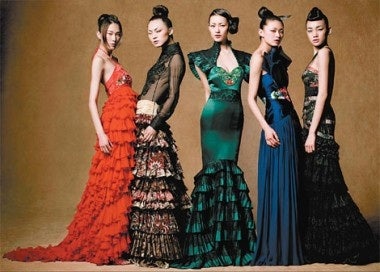Government Pushing Support Of Local Brands To Compete With International Giants#

NE-TIGER founder Zhang Zhifeng recently claimed "the only high-end Chinese brand is mine."
Following the release of the Chinese government's 12th five-year plan, which prominently advocates the nurturing of domestic Chinese brands that can compete on a global level and move up the value chain, we've seen a significant rise in the number of Chinese-language articles asking: just how far off are actual home-grown Chinese luxury labels? While a new generation of independent designers is now active in Beijing and Shanghai, pumping out a steady supply of avant-garde-leaning collections, influential brands are scarce. With the notable exception of Chinese brands supported by major international partners, such as the Hermes-backed Shang Xia, the Richemont-backed Shanghai Tang, and the French-Chinese jewelry house Qeelin, few clear leaders have emerged in the running to become China's first internationally successful premium marque.
A lack of competitive brands hasn't only annoyed the Chinese government, but has been, according to Chinese Ministry of Commerce officials, a key factor in the much higher prices charged for luxury brands in mainland China. In response to inquiries about the markup on high-end imports, which can cost up to 50 percent more than in Europe or North America, one official recently said there are three main factors causing prices to be so high: First, China's luxury and consumption taxes, which some countries simply do not have; Second, high transaction costs in China; Third, regional differences in promotions and a lack of unified pricing. However, as MSN China points out, some industry experts have added a fourth reason for China's high prices: an absence of domestic premium brands. As a result of the lack of local competition, these analysts say, foreign luxury brands can engage in "unreasonable discriminatory pricing" in the China market vis-à-vis their home markets.
From MSN (translation by Jing Daily team):
Currently, luxury brands are taking shape in China, mostly in the apparel, tea, wine, and cosmetics industries, but these are few and far between. The government has now turned its attention to this issue because, in addition to fears about losing purchasing power, it's worried that foreign luxury brands will take advantage of the lack of local brands to monopolize and then fully control the high-end market. Also, according to some sources, the government's concern about the luxury market is also tied up with national developmental planning in the fields of independent brand innovation and industrial restructuring.
Luxury insiders point out that luxury brands are born out of two main factors, one being history and the other a mature consumer base. However, there are virtually no domestic Chinese luxury brands that have these two characteristics, because home-grown brands tend to focus on short-term gains rather than nurturing the brand culture. The establishment of a brand requires a lot of time and money, two things that are in short supply when a brand is first starting out.
Still, the strong purchasing potential seen among luxury consumers has made many domestic [Chinese] brands eager to crack overseas markets. For example, NE-TIGER (previously on Jing Daily) founder and head designer Zhang Zhifeng claims that 65-70 percent of his items are sold in Europe and the U.S., with most of his furs, evening and wedding dresses selling in New York, Tokyo, Paris and Moscow.
(Zhang, who recently said that global luxury giants “come [to China] to invade cities and to occupy the land, to grab the market and to pan for gold in our prosperity,” says he is working to build China's top domestic luxury brand. -- JD)
Chen Deming of the Ministry of Commerce recently said that China's current crop of aspiring luxury brands can't yet meet the growing material needs of Chinese consumers. However, if we are to create domestic luxury brands in China, the first thing that needs to change is the conception of luxury goods prevalent among these domestic consumers.
The article goes on to note that the most important change that can wean Chinese consumers off of their single-minded pursuit of imported luxury brands will be a transition from the "show-off stage" of consumption to the stage of appreciation and rational consumption. This obviously won't happen in an instant, but will likely happen over the course of an extended, tiered timeline. While a small minority of elites may make the transition to "rational consumption" (理性的奢侈品消费) -- which is to say, purchases based on personal interest in brands and quality rather than trends -- and nurture the development of domestic luxury brands, it will take far longer for the nouveau riche or the emerging middle class to reach this level. As such, we're likely to see foreign brands like Louis Vuitton occupy that coveted spot at the top of the luxury heap in China for quite some time.